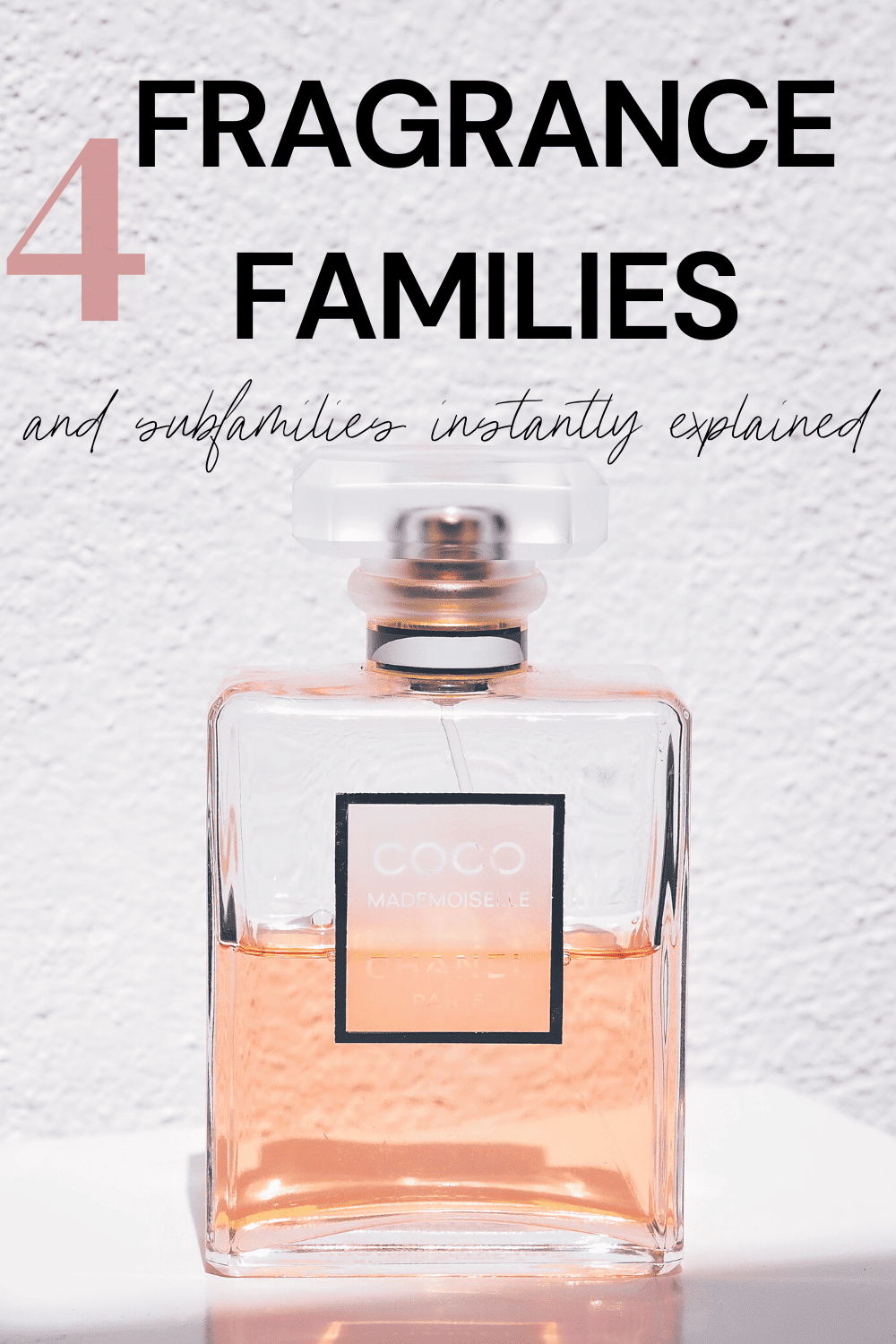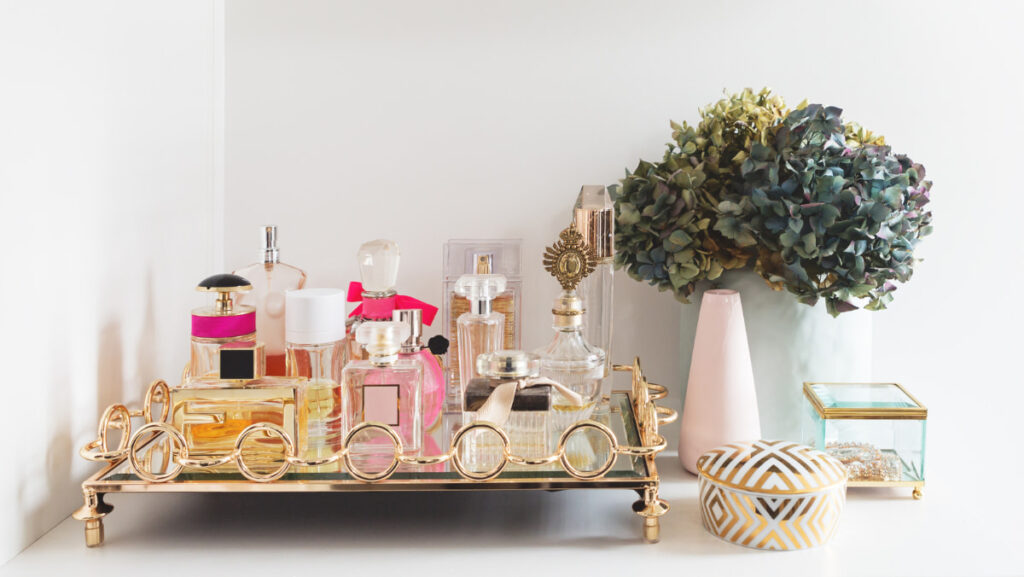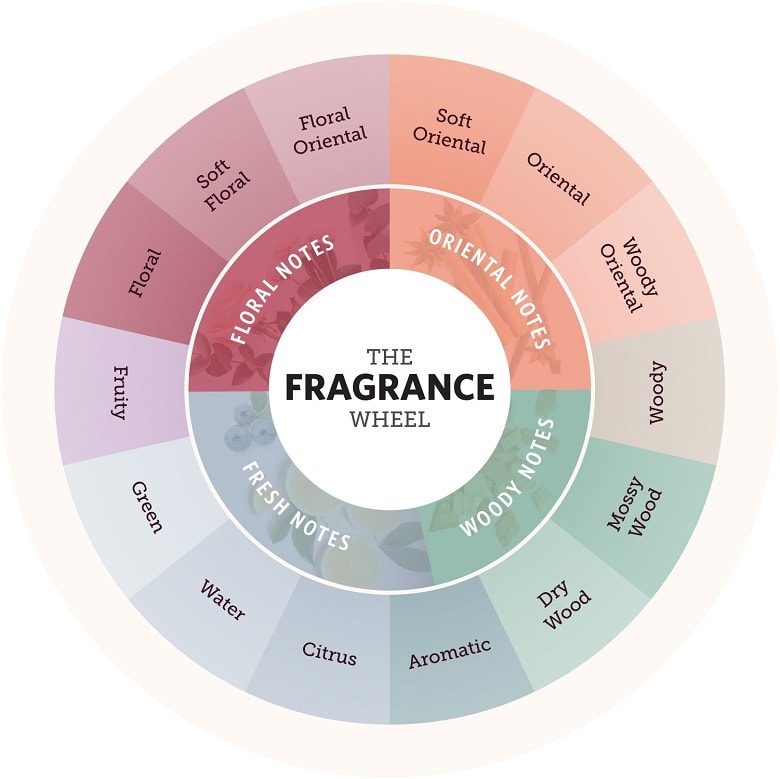
Have you ever wondered why some perfumes make you feel energized and refreshed while others bring a comforting sense of calm? It’s all about the fragrance families.
These categories group scents based on their dominant characteristics, helping guide your choices in a world overflowing with olfactory options.
If you’ve ever felt overwhelmed when trying to choose a new perfume or cologne, understanding fragrance families can be your secret weapon.
By knowing which family (or families) appeal most to your senses, you’ll be able to confidently navigate the sea of scent options.
In this article, we’ll take a deep dive into the fascinating world of fragrance families. We’ll explore everything from citrus and floral to oriental and woody fragrances.
Whether you’re looking for that perfect signature scent or just love learning about all things fragrance-related – this is where it gets interesting!
What Are Fragrance Families
When you’re on the hunt for a new perfume, it’s not just about the brand or the bottle. It’s also about understanding fragrance families.
So what are these exactly? Well, they’re essentially categories that scents fall into based on their dominant characteristics.
Think of it like this: You wouldn’t walk into a grocery store without knowing whether you’re after fruits, vegetables, or meats, right? The same goes for selecting your next scent.
To make sure you will be able to find your new favorite fragrance is helpful to understand the different fragrance families on which every scent is based. The four main fragrance families are:
Over the years, three more categories were kind of added to this perfume families list: fougère (fern), chypre (Cyprus), and gourmand. In some lists, you’ll spot them; in others, you don’t.
Floral is arguably the most popular family and contains perfumes that are predominantly flower-based. They can range from single-note soliflores (scents mimicking one particular flower) to complex bouquets featuring multiple flowers.
Moving onto Oriental, these scents are known for their warm and spicy notes. Think incense and amber–rich aromas that conjure up images of exotic lands far away from home.
The Woody family is characterized by its earthy undertones – think sandalwood or cedarwood. These fragrances often evoke feelings of being in a lush forest or cozy log cabin.
Finally, there’s the Fresh category which includes citrusy scents like lemon and grapefruit as well as aquatic smells reminiscent of fresh air and sea breezes.
Now why does this matter? By recognizing these fragrance families, you’ll be better equipped to select perfumes that suit your preferences.
Maybe you’re drawn towards woody fragrances because they remind you of autumn walks in nature, or perhaps floral notes uplift your mood every time – whatever it may be!
Explanation Of The Fragrance Wheel
Micheal Edwards, an international perfume expert, created the Fragrance Wheel to display the relationship between scents.
The wheel provides a visual representation of fragrances, which is ideal for helping you understand how they blend and contrast. It’s similar to the color wheel but for things that smell delightful.
He did this by grouping scents into families and subfamilies. There are four families and fourteen subfamilies on the wheel. The closer each subfamily is to another, the more likely it is to blend well.
This knowledge is not only helpful in creating perfumes, but it’s also valuable for finding your favorite scent. The four fragrance families are Amber, Florals, Fresh, and Woody. Let’s dive in and look closely at each family and its subfamilies.
Oriental
- Subfamilies: Woody Amber, Amber, and Soft Amber
- Common Notes: Warmth, vanilla, spice, bergamot, musk, pepper
- Perfumes to Try: Alien Goddess Intense, Salty Amber, Replica: Jazz Club
The oriental or amber family exudes exotic and sensual scents. It was previously called the Oriental family because of the deep, exotic, and spicy notes that it’s known for.
Amber fragrances usually feature a base scent of vanilla, musk, or resin, often in the form of sandalwood. If you want to look and feel sexy, the sensual scents of the amber family are the way to go.
Typically, in feminine fragrances, light floral essences are commonly blended with scents in the amber family to brighten the perfume. On the other hand, Masculine fragrances in the amber family tend to feature blends of woody scents.
Florals
- Subfamilies: Fruity, Floral, Soft Floral
- Common Notes: Jasmine, rose, ylang-ylang, fruit, patchouli, resin, musk
- Perfumes to Try: Burberry Her Eau de Toilette, Valentino Donna, English Pear and Freesia
When it comes to the vast world of fragrances, floral scents are undoubtedly the most iconic. They’re the ones that you’ll often find at the heart of your favorite perfumes. But have you ever stopped to consider just how intricate these aromatic bouquets really are?
Let’s delve into the nuances of floral scents. Each flower carries its own unique scent profile, making it a complex component in any fragrance blend. Take roses, for example; their aroma can range from sweet and soft to intense and spicy, depending on their variety.
You might not realize it, but many popular floral notes come from unexpected sources too. Jasmine is one such example, with its intoxicatingly rich scent being derived from tiny white flowers that bloom only at night.
On top of this, there’s a whole sub-category known as floral-fruity, where delicate flower aromas are combined with zesty fruit notes for a fresh twist.
They can be Single Floral (centered around the scent of one flower, like rose fragrances), Floral Bouquet (a blend of different flowers), or Soft Floral (floral notes combined with spicy or powdery notes).
Typically, fragrances in the floral family are less intense or lighter than those in the amber family. These are the perfect summer or springtime scents.
Did you know: English Pear and Freesia is internationally renowned female entrepreneur Jo Malone’s most popular fragrance. Jo Malone is the founder of two major fragrance brands.
Fresh
- Subfamilies: Water, Aromatic, Green, Citrus
- Common Notes: Green notes, citrus, herbs, sandalwood, musk, bergamot, light florals, ocean
- Perfumes to Try: Neroli Portofino Acqua, Wood, Sage & Sea Salt, Replica: Under the Lemon Trees
If you’re looking for those bright, clean, and fresh summertime scents without strong floral notes, the fresh fragrance family might have exactly what you need. Fresh fragrances have possibly the most complex notes in the perfume world.
You’ll often find fresh perfumes that are said to have a base of ‘green notes.’ This is best described as the scent of dew-covered grass in the morning or a cut stem of a plant.
As you venture into the world of fragrance families, one group you’ll undoubtedly encounter is citrus. Fresh, tangy, and invigorating citrus aromas can elevate your mood and energize your senses.
They include common fruits like lemons, limes, oranges, and grapefruits. Yet it’s not just the fruit that contributes to these alluring scents; the zest or rind also plays a significant role in creating distinctive fragrances.
The primary characteristics of citrus-based perfumes are their lightness and freshness. These are what make them particularly appealing during warmer months or as daytime fragrances.
When it comes to longevity on the skin, though, fresh scents tend to evaporate quickly compared to other fragrance families such as woods or orientals.
However, don’t be too quick to dismiss them! Layering different fresh fragrances can create complex profiles that linger longer on your skin.
Woody
- Subfamilies: Mossy Woods (known as the chypre fragrances), Woods, Dry Woods
- Common Notes: Cedarwood, sandalwood, citrus, orange blossom, patchouli
- Perfumes to Try: Oud Wood, Replica: By The Fireplace, Chloé Nomade Naturelle
Woody fragrances are warm, opulent, and comforting and are best suited for fall and winter. Base notes like sandalwood or the drier cedarwood allow for various combinations. Perfumes of the Woody fragrance family commonly feature blends of clean, spicy, or floral notes.
Woody scents are a broad and fascinating fragrance family that you’ll find in countless perfumes, aftershaves, and home fragrances. You’re likely familiar with some woody fragrances already – think of cedarwood or sandalwood.
These fragrances have a natural, earthy quality to them, often evoking images of forests or warm spices. They’re typically characterized by rich base notes that can linger for hours on your skin or fabric.
Although they’re best for the colder seasons, if you’re after a deep and mature fragrance, woody notes are ideal. These perfumes are perfect for fall holidays at the lake, grabbing a coffee on a gloomy day, or even date nights.
Now let’s talk about mixing fragrances; this is where things get interesting! Woody scents play well with others; they make an excellent base for other more volatile notes in perfumery compositions. For instance:
- Pairing them with floral notes creates depth while retaining freshness.
- Mixing them with spicy ingredients results in an exotic warmth that captivates attention.
What Are Fragrance Notes
Fragrance families explained: check! Onto the next subject, which is fragrance notes. Fragrance notes are elements that make up a fragrance. They’re classified as top notes, heart notes, and base notes.
This precisely named mix of ingredients forms the perfume accord, the introductory character of a scent. Perfume makers select notes to ensure a scent smells nice and evoke a special experience.
You can identify fragrance notes based on the time that passed. Top notes are those you smell incontinently after the fragrance first touches your skin.
Once this original burst fades, the heart notes kick in to form the substance of the fragrance. The base notes are the ones that last the longest when it comes to the scent.
Understanding these perfume types and fragrance notes can help you navigate the scent-sational universe of perfumes, empowering you to find a fragrance that truly captures your essence.
Top Notes
Top notes, occasionally related to as opening notes, form the top level of a fragrance. This means that the top notes are the scents you discover first after sprinkling on a fragrance.
Top notes are basically the first impression of a fragrance. Top notes generally fade fast, which means you will mainly smell them for the first five to fifteen minutes.
After that, they will transition into the basic fragrance. As a result, top notes generally correspond to lighter and lesser molecules.
Typical top notes include bergamot, lemon, orange zest, anise, grapefruit, and fresh herbs (basil, sage, lavender).
Heart Notes
As you may assume from their name, heart notes lie at the heart of a fragrance. They’re often known as middle notes because of this.
This scent level is the foundation of any fragrance and makes up roughly 40-80% of the definitive perfume.
Just before the top notes start to fade, the heart notes enter and will explosively impact the base notes. Heart notes are not to be taken lightly!
Typical heart notes include cinnamon, rose, ylang-ylang, lemongrass, and neroli.
Base Notes
The base notes will shine through once the top notes have entirely faded. Base notes make up 10-25% of the final perfume. Still, the base notes also blend with the heart notes to accentuate the complexity of the scent.
Where the top notes make the original imprint, the base notes are associated with the fragrance’s dry-down period, so base notes will produce the final, lasting mark.
Typical base notes include cedarwood, sandalwood, vanilla, patchouli, and musk.

Can You Mix Perfumes Together?
Yes, it’s definitely possible to mix perfumes together and create your own, unique scent. Layering scents doesn’t unavoidably mean sprinkling two fragrances directly on top of each other, though.
It can be a combination of a body spray or lotion with a fragrance, for example, or spraying one in your hair and the other on your wrists.
Either way, don’t be afraid and play around with creating your new favorite fragrance. There’s no right or wrong!
Now I understand this is still quite intimidating if you’ve never layered fragrances. So to give you a head start, here are some general rules to remember when picking the different types of perfumes you want to layer.
How To Choose Your Scent Family
When it comes to selecting a perfume, it’s not just about the brand or the bottle. You need to understand scent families. This knowledge will make your fragrance shopping experience more enjoyable and successful.
First off, let’s talk about why scent families are important. Perfumes aren’t created out of thin air – they belong to specific categories known as ‘families’.
These families give you an idea of what a fragrance might smell like, even before you spritz it on your skin.
Now, how do you find out which scent family suits you best? It starts with understanding your personal preferences. Do floral notes bring back cherished memories? Or maybe spicy scents make you feel bold and daring?
Here are some simple steps to guide you:
- Identify Your Favorite Scents: Think about smells that make you happy – fresh laundry, blooming flowers, morning coffee – these can be clues towards identifying your preferred scent family.
- Try Before You Buy: Once at the store (or browsing online), try different fragrances from each scent family. Remember that perfumes can evolve throughout the day – what’s called top notes (the first impression), heart notes (the main body of the perfume), and base notes (which give depth).
- Consider Lifestyle & Personality: If you lead an active lifestyle outdoors, fresh or citrusy scents may suit well for their energizing qualities.
- Time of Year Matters Too: Warmer seasons usually call for lighter scents, such as floral or aquatic while colder months could pair well with richer oriental or woody fragrances.
As part of this process, don’t rush! Allow yourself time to explore and savor each aroma properly before making a decision.
Tips For Testing Perfumes
Testing perfumes can be a sensory delight, but it’s important to approach this process strategically to avoid olfactory overload. Here are some tips:
- Limit the number of perfumes you test: Stick to three or four fragrances per visit to prevent your sense of smell from becoming overwhelmed.
- Use fragrance blotters: Before applying perfume directly on your skin, spray it onto a blotter. This allows you to get an initial sense of the perfume’s character without the influence of your body’s natural scent.
- Give it time: Allow the perfume to evolve on your skin. A perfume’s true character is revealed in its middle and base notes, which may take up to an hour to fully emerge.
Factors Influencing Perfume Choice
When selecting a perfume, consider the following factors:
- Personal preference: Your subjective taste is the top factor in choosing a perfume. Explore different fragrance notes to understand what appeals to your olfactory palette.
- Occasion: Some scents are better suited for certain occasions. Lighter fragrances might be ideal for daily wear, while more luxurious, intense ones can be reserved for special events.
- Season: The weather can influence how perfume develops on your skin. Some woody fragrances work better in cold weather, while fresh, citrusy scents are often preferred for warmer months.
- Skin type: Your skin type can affect how a perfume smells and how long it lasts. Oily skin tends to retain fragrance longer than dry skin.
Conclusion: Embracing Your Signature Scent
Finding your signature scent isn’t just about picking a perfume off the shelf. It’s an intimate journey of self-discovery and personal expression.
You’ve explored different fragrance families, delved into their unique characteristics, and understood how they can influence mood and evoke memories.
You’ve learned that fragrances fall into seven main families – floral, oriental, woody, fougère (fern), chypre (Cyprus), citrus, and gourmand. Each family offers a distinct olfactory experience:
- Floral scents are romantic and feminine, often incorporating musk fragrances
- Oriental or amber fragrances exude warmth and sensuality
- Woody notes bring out depth and sophistication
- Fougère evokes freshness with its herbaceous quality
- Chypre is earthy yet slightly sweet
- Fresh or Citrus smells are refreshing, like a summer day
- Gourmand fragrances remind us of sweet treats
Remember to consider factors like your personality type, lifestyle preferences, or even the seasons while selecting a fragrance. For example, if you’re outdoorsy or prefer natural environments, woody or fresh citrus scents might appeal to you more.
However, it’s not all set in stone! The beauty of fragrances lies in their versatility – don’t shy away from experimenting with different scent profiles until you find one that feels uniquely ‘you’.
Ultimately though, it’s all up to you – there’s no ‘one-size-fits-all’ answer here because everyone has unique tastes regarding what they want their personal fragrance story to be.
Frequently Asked Questions
shop my favorite fragrances


Such an interesting read Simone! xx
Danielle’s Beauty Blog
I’m happy to hear this, thanks Danielle! xx
This is such a wonderful and interesting post, I adore perfumes and love learning something new about them! This was super interesting to read, thank you so much for sharing. <3
http://www.couture-case.com/
I’m so happy to hear that you liked it! Thanks for the love. <3